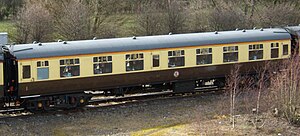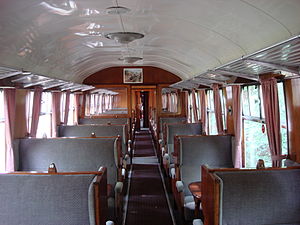British Railways Mark 1
| British Railways Mark 1 | |
|---|---|

Mark 1 Open First riding on Commonwealth bogies pictured empty in Tyne Yard, Gateshead, England. 12 March 2009
|
|

Interior of a Mk1 SO (Standard Open) Colne Valley Railway
|
|
| In service | 1951– |
| Manufacturer | BR Workshops, Cravens & others |
| Constructed | 1951–1963 |
| Operator(s) | British Railways |
| Specifications | |
| Car body construction |
Steel Body-on-frame, non-integral |
| Car length | 57 ft 0 in (17.37 m) or 63 ft 6 in (19.35 m) |
| Doors | hinged slam |
| Maximum speed | 90 mph (140 km/h) or 100 mph (160 km/h) |
| Train heating | Steam or electric or both |
| Bogies | BR1, BR2, Commonwealth or B4 |
| Braking system(s) | automatic vacuum, air, or dual |
| Coupling system | Drawhook or retractable knuckle coupler resting on drawhook |
| Track gauge | 4 ft 8 1⁄2 in (1,435 mm) |
British Railways Mark 1 was the family designation for the first standardised designs of railway carriages built by British Railways. Following nationalisation in 1948, BR had continued to build carriages to the designs of the "Big Four" companies (the Great Western, Southern, London Midland and Scottish and London and North Eastern railways), and the Mark 1 was intended to be the standard carriage design for use across all lines, incorporating the best features of each of the former companies' designs. It was also designed to be much stronger than previous designs, to provide better protection for passengers in the event of a collision or derailment.
The Mk 1 coaches were built in two distinct tranches: the early vehicles (1951–60) and the 'Commonwealth' stock (named from the type of bogie used) from 1961 onwards.
The design was used for hauled passenger stock, multiple unit carriages and non-passenger carrying stock. For passenger stock, construction continued from 1951 to 1963, while multiple units and non-passenger carrying stock continued to be built until 1974.
These were constructed in two lengths. Most had underframes 63 ft 5 in (19.33 m) long, with bogies at 46 ft 6 in (14.17 m) centres; the body was 64 ft 6 in (19.7 m) long if the coach was gangwayed, or 63 ft 5 3⁄4 in (19.35 m) if non-gangwayed. A smaller number had underframes 56 ft 11 in (17.3 m) long, with bogies at 40 ft (12.2 m) centres; the body was 58 ft (17.7 m) long if the carriage was gangwayed, or 57 ft 1 3⁄4 in (17.4 m) if non-gangwayed. The shorter vehicles were intended for use where the track curvature was too tight to accommodate the longer vehicles, due to excessive overhang.
These lengths allowed for compartments or seating bays 6 ft 3 in (1.91 m) wide, plus space for toilets and entrance vestibules; a typical design of Mark 1 vehicle, the TO (Open Third class), had eight seating bays, three entrance vestibules and a pair of toilets at one end. This provided reasonable space. Care was taken to ensure that passengers could enjoy an unobstructed view out of the train from all seats. Seats were aligned to windows and on the long-distance design of Mark 1, the windows had a low sill, just 25 inches (635 mm) above the floor.
...
Wikipedia
